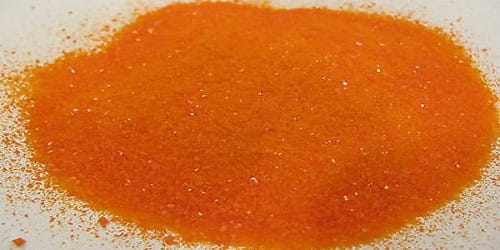Potassium Dichromate is used for the Chromyl chloride test.
Potassium dichromate is used for preparing strong cleaning solutions for glassware and for etching materials. When salt-containing chloride is treated with Potassium dichromate (K2Cr2O7) and con. H2SO4 reddish-brown vapors of chromyl chloride are obtained.
K2Cr2O7 + 4KCl + 6H2SO4 → 2CrO2Cl2 (Chromylchloride) + 6 KHSO4 + 3H2O
This reaction is used in the detection of chloride ions in qualitative analysis. Potassium dichromate is prepared by adding to the neutral yellow chromate of potassium in solution, a moderate quantity of one of the stronger acids. Potassium creates a slow, weak pulse, heart rhythm irregularities, heart block, and blood pressure drop eventually.
Other Uses are:
- It is used in the volumetric analysis.
- In chrome tanning in the leather industry.
- In calico printing and dyeing. It is used to clean glassware and as an etching material.
- In photography and in hardening gelatin film, it is used in photographic screen printing.
- It is a common reagent used in analytical chemistry for classical “wet tests”.
- It has uses in leather tanning, photographic processing, cement, and wood staining.
- Medically it can be used externally as an antiseptic, caustic, and astringent.
- Used in cement to retard the setting of the mixture and to improve its density along with the texture.
- It is used as an oxidizing agent in many applications and is also used to prepare various products such as waxes, paints, glues, etc.
Potassium permanganate is commercially prepared by mixing solution of potassium hydroxide and powdered manganese oxide with oxidizing agents like potassium chlorate.
Safety: potassium dichromate is carcinogenic and highly toxic which increased the risk of developing lung cancer. Experiments show that ingestion of fewer than 40 grams can be deadly or cause severe harm to the individual’s health. After ingestion, the material can generate chemical burns in the oral cavity and gastrointestinal tract. It is also very corrosive and skin/eye contact can cause severe irritation and burning sensation, and even lead to blindness.










